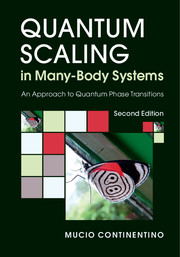Book contents
- Frontmatter
- Dedication
- Contents
- Preface
- 1 Scaling Theory of Quantum Critical Phenomena
- 2 Landau and Gaussian Theories
- 3 Real Space Renormalisation Group Approach
- 4 Renormalisation Group: the ∊-Expansion
- 5 Quantum Phase Transitions
- 6 Heavy Fermions
- 7 A Microscopic Model for Heavy Fermions
- 8 Metal and Superfluid–Insulator Transitions
- 9 Density-Driven Metal–Insulator Transitions
- 10 Mott Transitions
- 11 The Non-Linear Sigma Model
- 12 Superconductor Quantum Critical Points
- 13 Topological Quantum Phase Transitions
- 14 Fluctuation-Induced Quantum Phase Transitions
- 15 Scaling Theory of First-Order Quantum Phase Transitions
- Appendix
- References
- Index
10 - Mott Transitions
Published online by Cambridge University Press: 04 May 2017
- Frontmatter
- Dedication
- Contents
- Preface
- 1 Scaling Theory of Quantum Critical Phenomena
- 2 Landau and Gaussian Theories
- 3 Real Space Renormalisation Group Approach
- 4 Renormalisation Group: the ∊-Expansion
- 5 Quantum Phase Transitions
- 6 Heavy Fermions
- 7 A Microscopic Model for Heavy Fermions
- 8 Metal and Superfluid–Insulator Transitions
- 9 Density-Driven Metal–Insulator Transitions
- 10 Mott Transitions
- 11 The Non-Linear Sigma Model
- 12 Superconductor Quantum Critical Points
- 13 Topological Quantum Phase Transitions
- 14 Fluctuation-Induced Quantum Phase Transitions
- 15 Scaling Theory of First-Order Quantum Phase Transitions
- Appendix
- References
- Index
Summary
Introduction
In this chapter we study metal–insulator transitions which occur due to correlations between the charge carriers. This quantum phase transitions results from the competition between kinetic energy and Coulomb repulsion where the latter has the tendency to localise the electrons. The simplest model which describes this competition is the one-band Hubbard model with its two energy scales, the bandwidth W and the Coulomb repulsion U between electrons of opposite spins on the same site. For a fixed density of electrons, n = 1; as the ratio U/W increases, we expect to find a zero-temperature phase transition from a metallic state to an insulator where the electrons are frozen at the lattice sites. The method employed here to investigate this transition is the Gutzwiller approach (Gutzwiller, 1965). This is a variational method which played an important role in providing a framework for the ideas of Mott on the problem of the metal–insulator transition (Mott, 1974). On the metallic side of the transition, this approach describes a metal with renormalised Fermi liquid parameters, essentially with enhanced effective mass and uniform susceptibility. This is the so-called highly correlated electron gas (Brinkman and Rice, 1970) for which the metal oxide V2O3 is the prototype system. In the insulating side, Gutzwiller's approximation yields a noninteracting system of localised electrons. This insulating phase is incompressible, i.e. has zero compressibility and infinite zero temperature susceptibility. The latter is not a consequence of interactions but simply due to the divergence of the Curie susceptibility, χ ∝ 1 /T, of non-interacting moments at T = 0. Then, in Gutzwiller's approach the transition is from a paramagnetic metal to a paramagnetic insulator. We will continue using the designation Mott transition to describe this type of phase transition where the insulating phase has no long-range magnetic order. In real systems, most frequently, localisation due to interactions is accompanied by the appearance of antiferromagnetic order.
- Type
- Chapter
- Information
- Quantum Scaling in Many-Body SystemsAn Approach to Quantum Phase Transitions, pp. 129 - 145Publisher: Cambridge University PressPrint publication year: 2017



